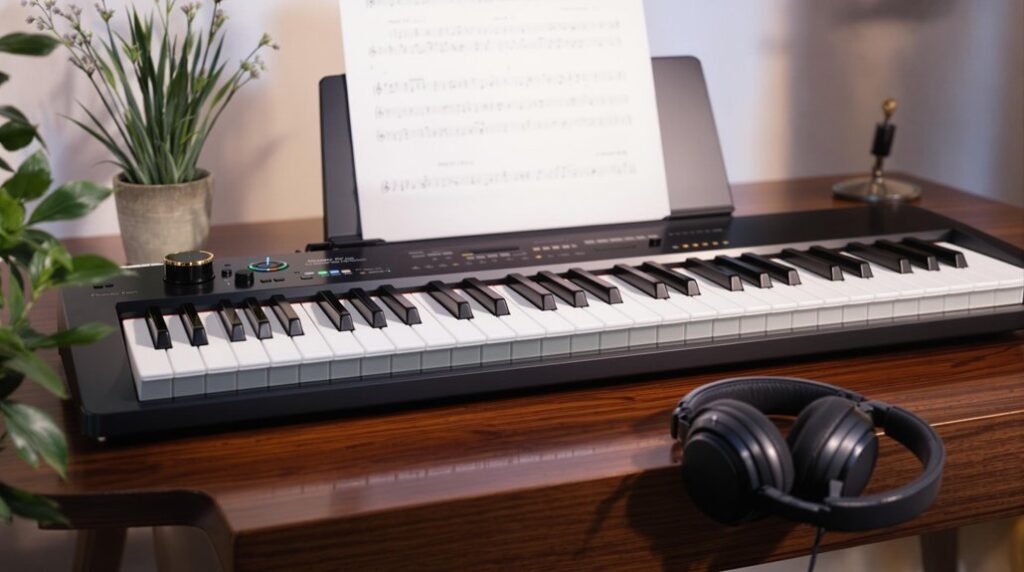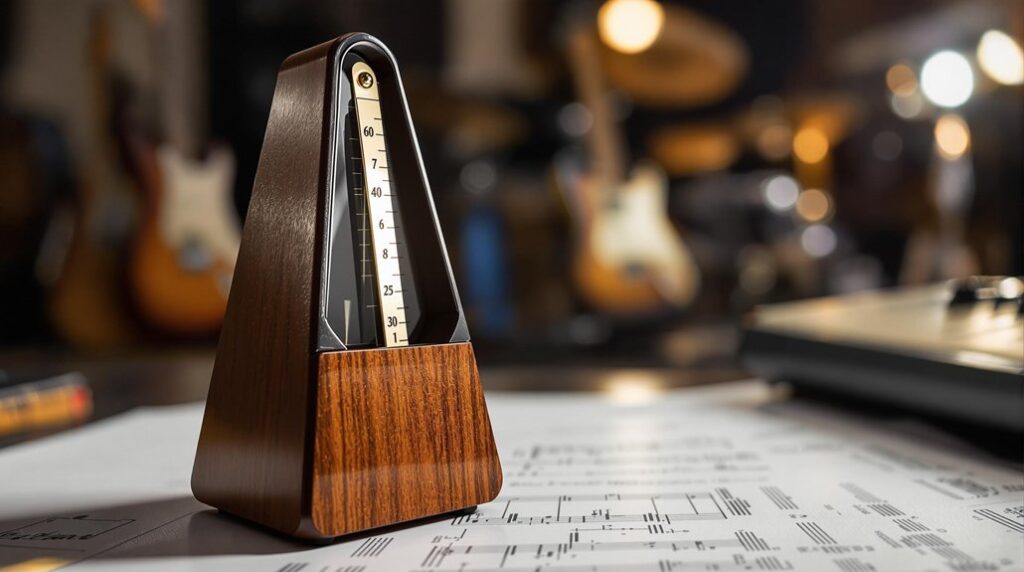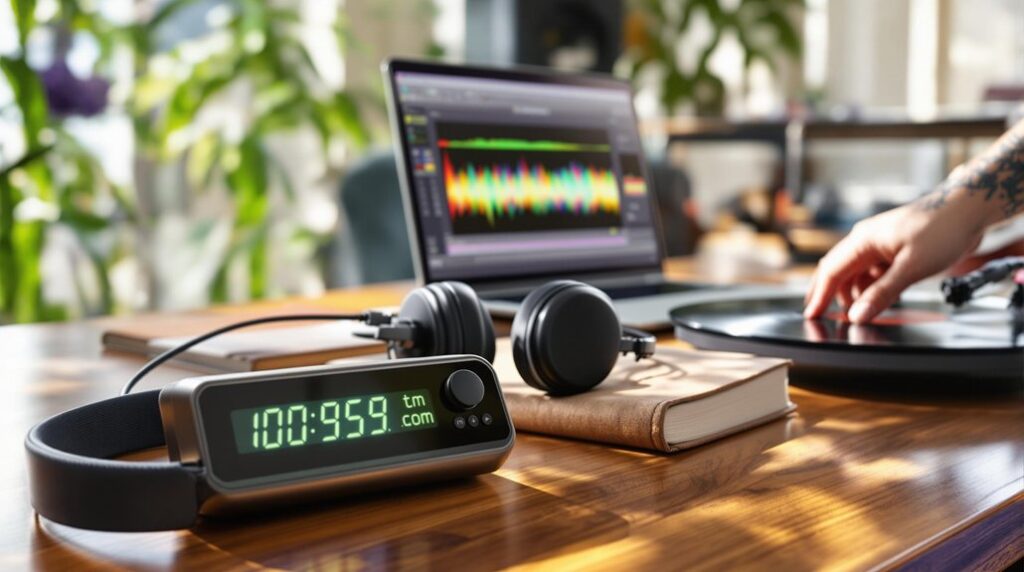Mastering the quarter rest involves understanding its role in creating beats of silence in music. It’s essential to recognize the quarter rest symbol and count it like a note. Begin by clapping to the beat and incorporating silent beats to practice recognizing the rest. Use a metronome to improve timing, starting slow and increasing speed gradually. Visualize and compare different rest symbols to enhance your understanding. Integrate rests while counting to synchronize with the music’s rhythm. By following these steps, you’ll add depth and expression to your performance. Let’s explore further to enhance your musical mastery.
Key Takeaways
- Practice clapping exercises with silent beats to grasp the quarter rest.
- Use a metronome to synchronize claps and silent beats for precise timing.
- Visualize and recognize quarter rest symbols to ensure correct placement in rhythm.
- Count out loud, including the rests, to maintain accurate beat structure.
- Gradually increase tempo with a metronome to enhance timing accuracy and control.
Understanding the Quarter Rest
In music notation, the quarter rest symbol, which looks like a squiggle, signifies one beat of silence. This rest is equivalent in duration to a quarter note, creating a moment of musical pause within the rhythm. When you’re counting rhythms, you treat the quarter rest just like a note, ensuring it occupies its designated time slot. This silent rhythm is essential for maintaining the integrity of the piece you’re playing.
To master the quarter rest, focus on understanding its role in rhythmic interpretation. By incorporating quarter rests into your practice, you’ll develop a keen sense for note duration and the importance of musical pauses.
Begin by clapping and counting out rhythms that include quarter rests. This practice helps you internalize the concept of silence as part of the rhythm.
Identifying quarter rests in sheet music and accurately executing them during performance will enhance your overall musical expression. Remember, the silence created by a quarter rest is as important as the notes you play. By paying close attention to these silent rhythms, you can achieve greater rhythmic precision and a deeper understanding of the music you’re performing.
Visualizing Notes and Rests
Visualizing notes and rests is vital for accurately interpreting and performing music. When you look at a piece of music, distinguishing between quarter notes and quarter rests is essential.
The quarter rest symbol, resembling a squiggle, indicates one beat of silence. By understanding rest duration, you can guarantee that these silent beats fit seamlessly into the rhythm, maintaining the flow of the music.
Rest placement is equally important. Knowing where these rests occur within a measure helps you manage the timing and spacing of your notes. Imagine a quarter rest as a pause that provides contrast and enhances the dynamics of your performance.
It’s not just about playing notes; it’s about creating a balance between sound and silence. To practice, start by visually scanning your sheet music to identify all the quarter notes and quarter rests. This will help you internalize their rhythmic value and assure you’re giving each rest its full duration.
Incorporating these rests into your playing or singing adds depth and expression to your music. Remember, silence is as powerful as sound, and mastering rest placement can notably improve your musical interpretation.
Clapping Exercises
To master quarter rests, start by clapping to the beat of the quarter note for one full beat, ensuring your timing is accurate.
Then, incorporate silent beats between your claps to practice recognizing and maintaining the quarter rest.
Using a metronome can help you keep precise timing and improve your rhythm control as you gradually increase the tempo.
Timing and Accuracy
Mastering timing and accuracy with clapping exercises involves clapping to the beat of the quarter note for one full beat, making sure each clap aligns perfectly with the metronome.
To develop rhythm control, start by setting your metronome to a comfortable tempo. Clap exactly on the beat, focusing on making each clap precise and consistent. This practice helps engrain the sense of steady timing into your muscle memory.
Begin by clapping along with the metronome for a few measures. Pay close attention to the alignment of your claps with the metronome’s ticks. If your claps are off, adjust your timing until they sync perfectly.
Consistent practice is essential to develop both rhythm control and muscle memory, allowing your body to naturally keep time.
As you become more comfortable, gradually increase the metronome’s tempo. This will challenge your coordination and further solidify your sense of timing. Remember, precision is key; don’t rush the process. Take your time to make sure each clap is synchronized with the metronome.
Silent Beat Practice
Incorporating silent breaks between your claps helps you grasp the concept of the quarter rest and strengthens your overall rhythm control. Start by clapping to the beat of the quarter note for one full beat, then integrate a quiet break after each clap. This silent break application will help you internalize the feeling of the quarter rest.
To start, clap your hands on the first beat and stay quiet on the second. This exercise ensures you understand beat subdivision and can maintain consistent musical timing. Focus on maintaining a steady tempo, as this is vital for developing rhythmic control.
As you practice, count out loud: ‘One, (silent) Two, (silent) Three, (silent) Four, (silent).’ This counting method helps reinforce the silent breaks and guarantees you’re accurately placing your rests. Remember, the goal is to make the silence as purposeful and measured as your claps.
Dedicate regular practice sessions to these exercises to improve your muscle memory and rhythmic control. Over time, you’ll find your ability to maintain precise musical timing and beat subdivision has notably improved, making you more adept at handling quarter rests in any musical context.
Metronome Integration
Using a metronome in your clapping exercises establishes a consistent tempo, helping you improve timing and rhythm accuracy. This practice is vital for achieving tempo control and rhythm mastery.
Here’s how to incorporate a metronome effectively into your clapping exercises:
- Start Slow: Begin with a slower tempo. This allows you to focus on the accuracy of each clap and rest. A slower pace helps you internalize the rhythm before increasing the challenge.
- Sync Your Claps: Clap along with the metronome’s beats. Make sure each clap aligns perfectly with the metronome’s click. This synchronization helps you develop a strong sense of timing.
- Practice Silent Beats: Incorporate silent beats where you don’t clap but maintain the tempo internally. This is essential for mastering quarter rests. For instance, clap on beats 1, 2, and 4, and rest on beat 3.
- Track Your Progress: Keep a record of your exercises. Note the tempos you start with and how you progress over time. Gradually increase the metronome speed as you become more comfortable with the tempo and rhythm.
Writing the Quarter Rest
To write a quarter rest, you start with a squiggly line that resembles the letter ‘Z’ on its side. This symbol indicates a rest duration of one beat, meaning there’s a moment of silence in the music for that length of time.
The rest placement is vital; it should be positioned on the middle line of the staff. This helps guarantee that it’s easily recognizable and accurately interpreted within the context of the music.
First, place your pen or pencil on the middle line of the staff. Draw a small downward stroke, then angle it sharply to the left before drawing another downward stroke. Finally, angle it back to the right, finishing with a small tail. This distinctive shape is what characterizes the quarter rest.
Practice is essential to mastering the quarter rest. Regularly writing it out on music sheets will help you achieve precision and uniformity.
Understanding how to write quarter rests is necessary for mastering rhythmic notation in music. By confirming the rest duration and rest placement are correct, you’ll be able to convey the intended silence in your musical compositions effectively.
Keep practicing, and soon it’ll become second nature.
Identifying in Sheet Music
To identify a Quarter Rest in sheet music, look for the distinctive squiggly symbol that indicates a silent beat.
Pay attention to its placement on the staff in relation to other notes.
Practice marking these rest positions regularly to enhance your reading fluency.
Recognizing Rest Symbols
One of the first steps in mastering sheet music is recognizing rest symbols, particularly the quarter rest, which signals a one-beat silence. Understanding rest symbol interpretation is essential for any musician. By accurately identifying and counting silent beats, you can maintain the rhythm and timing necessary for a polished performance.
The quarter rest symbol resembles a squiggle or a stylized ‘Z,’ and it’s crucial to know how to spot it. Here are some tips to help you recognize rest symbols in sheet music:
- Look for the squiggle: The quarter rest looks like a small zigzag or a lightning bolt drawn in the middle of the staff. Familiarize yourself with its shape.
- Check the context: Often, the placement of rests will follow logical rhythmic patterns. If you’re counting beats, you’ll notice the quarter rest fits into a one-beat slot.
- Compare with other rests: To avoid confusion, compare the quarter rest with other rests like the half rest (which looks like a hat) and the whole rest (which looks like an upside-down hat).
- Practice with examples: Use sheet music examples to practice identifying and counting rests. The more you practice, the more intuitive recognizing these symbols will become.
Marking Rest Positions
Building on your ability to recognize rest symbols, let’s focus on marking rest positions in sheet music to guarantee precise rhythm and timing in your performance. Rest positions, indicated by symbols like the quarter rest, show where silence must occur.
A quarter rest, resembling a squiggle, signifies a silent beat and is essential for maintaining rest duration and timing. To accurately identify and mark these rests, you’ll need to pay close attention to their placement on the staff. Each quarter rest signals a pause for one beat, which is vital for rhythmic accuracy.
Start by scanning your sheet music for these squiggles. They typically appear in line with the beat structure, ensuring that the silence aligns perfectly with the overall rhythm.
Counting is also key. As you count the beats in each measure, include the rests in your counting. For example, if you have a measure with three quarter notes and one quarter rest, count ‘1, 2, 3, rest.’ This method helps you internalize the rhythmic structure and perform with precision.
Understanding the placement and significance of quarter rests allows you to interpret and perform the music correctly. By mastering rest positions, you guarantee that your performance maintains the intended rhythmic flow.
Practicing With a Metronome
Setting the metronome to your desired tempo establishes a consistent beat that will help you stay on rhythm and accurately time your quarter rests. One of the primary metronome benefits is its ability to provide tempo control, ensuring you maintain a steady pace. This tool is invaluable for practicing strategies focused on rhythm accuracy, allowing you to refine your timing and precision.
Here’s how you can effectively use the metronome in your practice:
- Start Slow: Begin with a slow tempo to make sure you can accurately switch between quarter notes and quarter rests. This helps in building a solid foundation.
- Gradual Increase: Once comfortable, gradually increase the tempo. This challenges your rhythm control and helps in adapting to different speeds.
- Silent Counts: Use the metronome to practice silent counts. Play quarter notes and then count the rests silently, making sure you keep the beat.
- Switch Patterns: Alternate between different rhythmic patterns. For example, play two quarter notes followed by two quarter rests. This variation aids in maintaining focus and improving versatility.
Frequently Asked Questions
How to Draw a Quarter Rest Step by Step?
To draw a quarter rest, start with a small vertical line. Curve it right, then left, creating a squiggly shape. Verify it doesn’t touch the staff lines. Practice these drawing techniques to add artistic flair to your musical symbols.
How to Do a Quarter Rest?
To do a quarter rest, observe the musical symbol, which looks like a squiggly line. Recognize its rest duration as one beat of silence. Accurate notation guarantees you maintain the rhythm by pausing for the correct time.
What Does a 1/4 Note Rest Look Like?
A quarter rest looks like a squiggly symbol. Understanding its meaning is essential for rhythm. Identify quarter rest placement in the music staff as it occupies the same space where a note would, indicating a silent beat.
How Long Do You Rest for a Quarter Rest?
You rest for one beat when you see a quarter rest. Focus on rest duration and counting to maintain musical timing and rhythm. It’s essential for achieving accurate timing in your performance.
Conclusion
Mastering the quarter rest is essential for any musician. You’ve learned to understand and visualize it, practiced clapping exercises, and written it yourself.
Identifying quarter rests in sheet music and practicing with a metronome will reinforce your skills. Keep at it, and soon, incorporating quarter rests will become second nature.
Remember, every rest is an opportunity to add rhythm and expression to your music. Stay dedicated, and you’ll master this fundamental aspect of musical notation.




